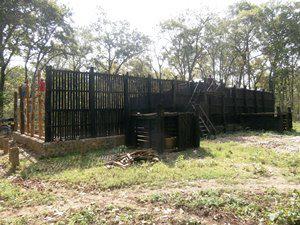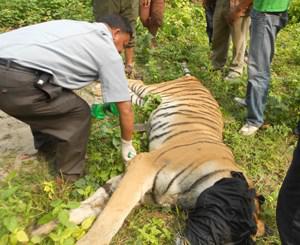Rajendra Dhungana
Other projects
21 Nov 2019
Strengthening Human-Big Cats Conflict Mitigation Efforts in Chitwan National Park, Nepal
The project aims to characterize spatio-temporal pattern of human casualties and livestock depredations by tiger, explore causes and context of attacks, and summarize adopted mitigation measures.

Tiger Enclosure.
Tiger Panthera tigris is globally endangered and despite extensive conservation efforts experiences continues relentless decline in most of its distribution range. Human-Tiger Conflict (HTC) is identified as one of the major conservation threats which may lead to retaliatory tiger killings and negate the public attitudes towards tiger conservation.

Tranquillized man-eater tiger under examination, before being kept in captivity. © Lalit Malla
As a collaborator of ‘Global Tiger Recovery Program’ endorsed in Tiger Summit 2010, Nepal is required to double the tiger population by 2022. Chitwan National Park (CNP) harbors the largest tiger population of Nepal and fortunately shows increasing population trend in recent years. However, HTC exists as a prominent threat which may hinder the momentum of tiger increment and affect long term viability of such isolated tiger population. Tigers are reported of killing up to 19 people and 40-50 livestock each year in CNP and surrounding buffer zone resulting unreceptive responses from local communities. This scenario has underscored the need for conflict mitigation and conservation awareness.
The project is designed to investigate spatial and temporal patterns of human casualties and livestock depredations along with their relationships with socio-ecological correlates, assess causes and context of tiger attacks, and summarize adopted mitigation measures. Especially, the study will prepare HTC maps, and systematically analyze the information on conflict incidents, problem tigers, and monetary losses and compensation payments to tiger attacks. The effects of correlates such as national park frontage, forested area, human population, and livestock population on tiger attack rates will also be examined. The conflict data primarily collected from CNP office will be verified and/or checked by questionnaire surveys, key informant interviews, field observations and interactions with officials. Conservation awareness programs to be organized in buffer zone of CNP include awareness workshops and group meetings, school programs, and publication of awareness materials.
In overall, the project is expected to give a comprehensive picture of HTC of CNP and buffer zone for 2007-2014 which will be ultimately helpful in mitigating HTC and formulating conflict management plans and tiger conservation strategies. Awareness programs will be crucial in developing positive attitude, raising awareness level, and motivating local people and students so as to obtain support for tiger conservation.